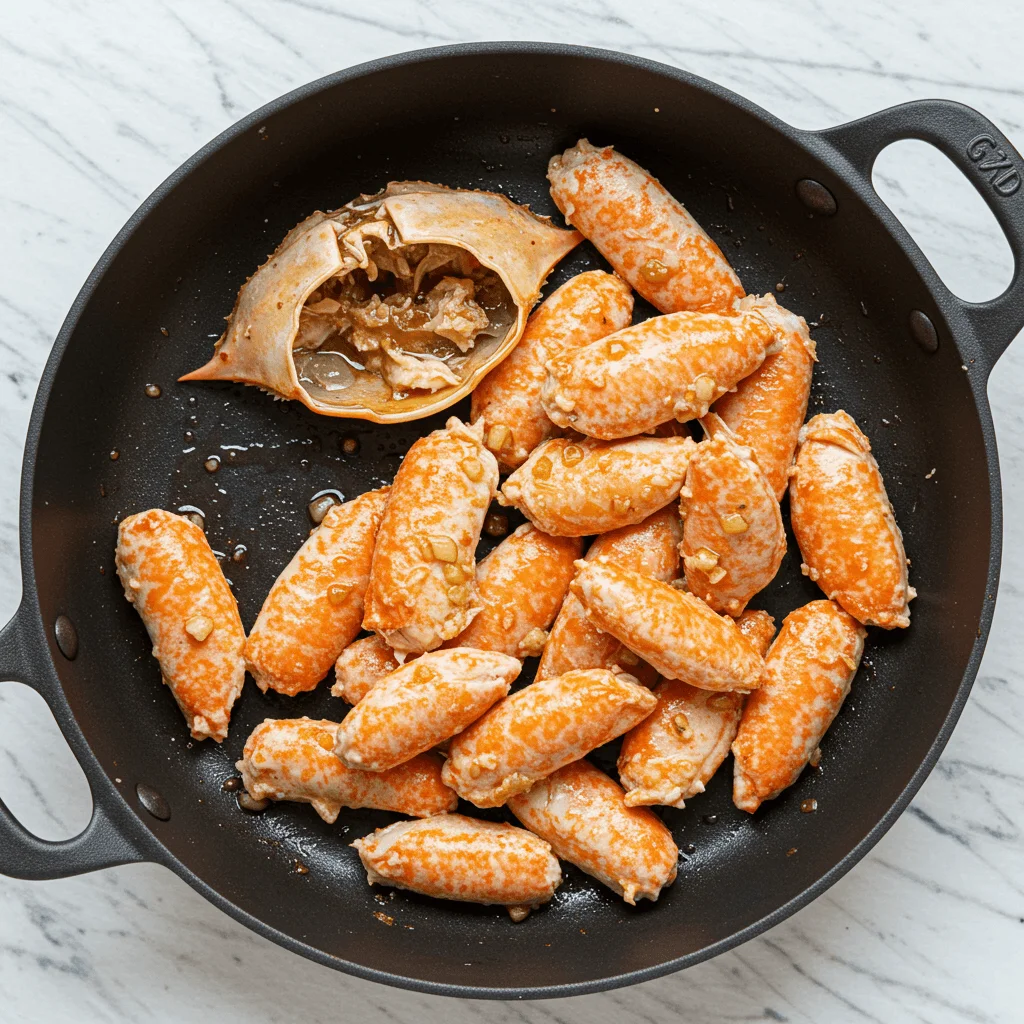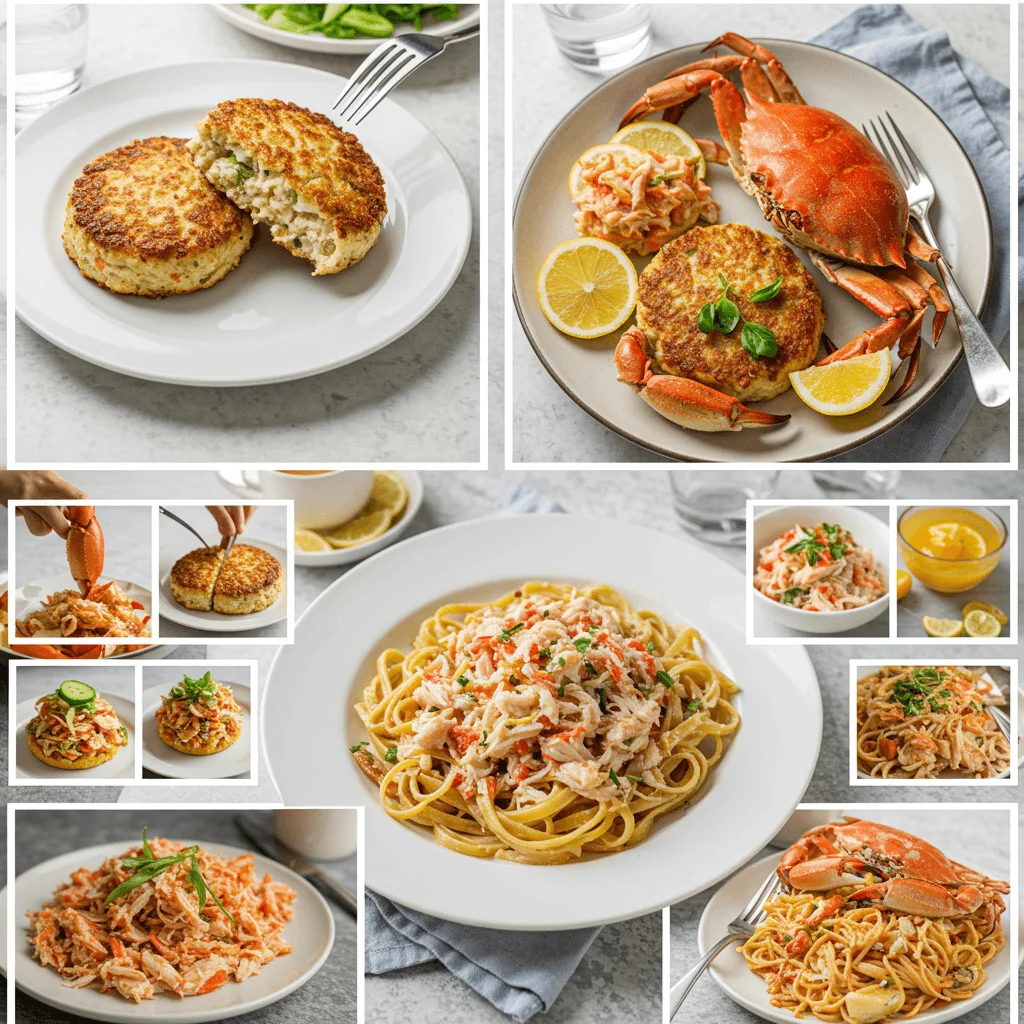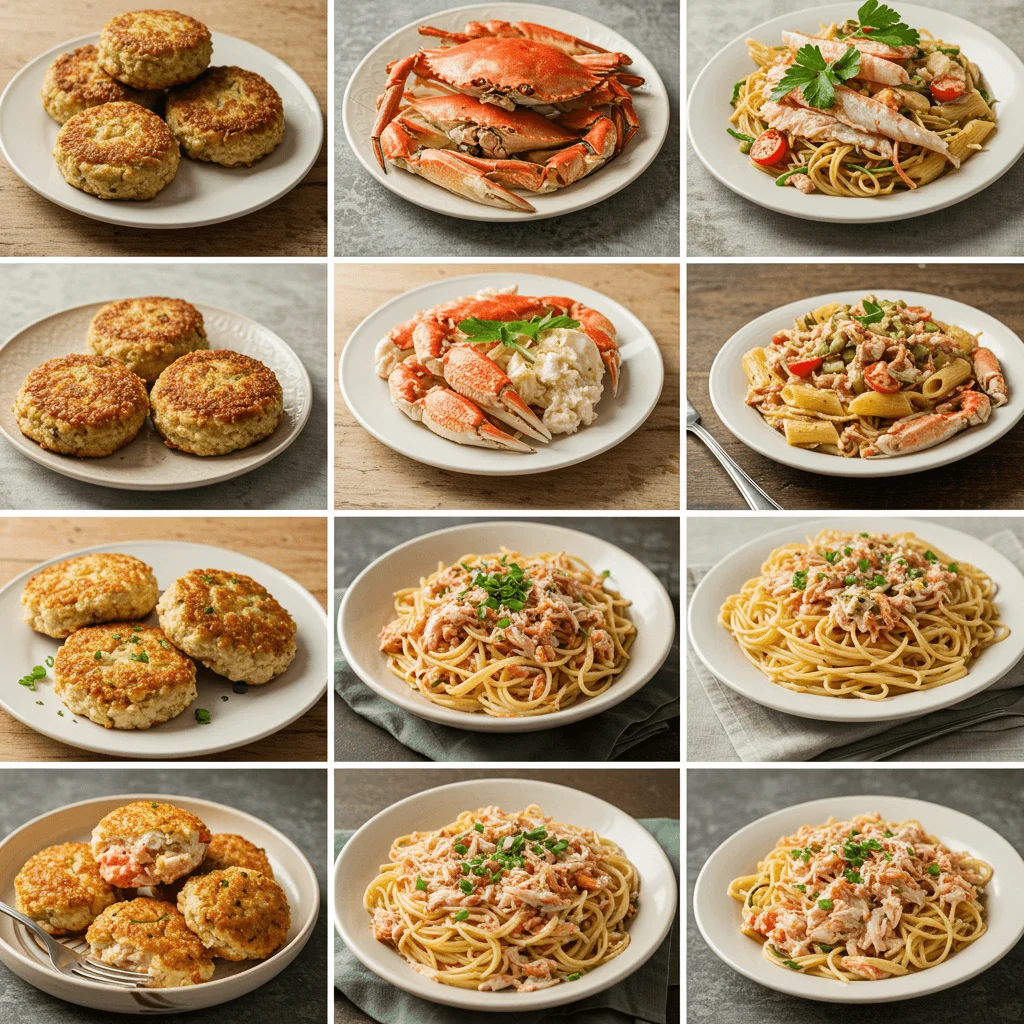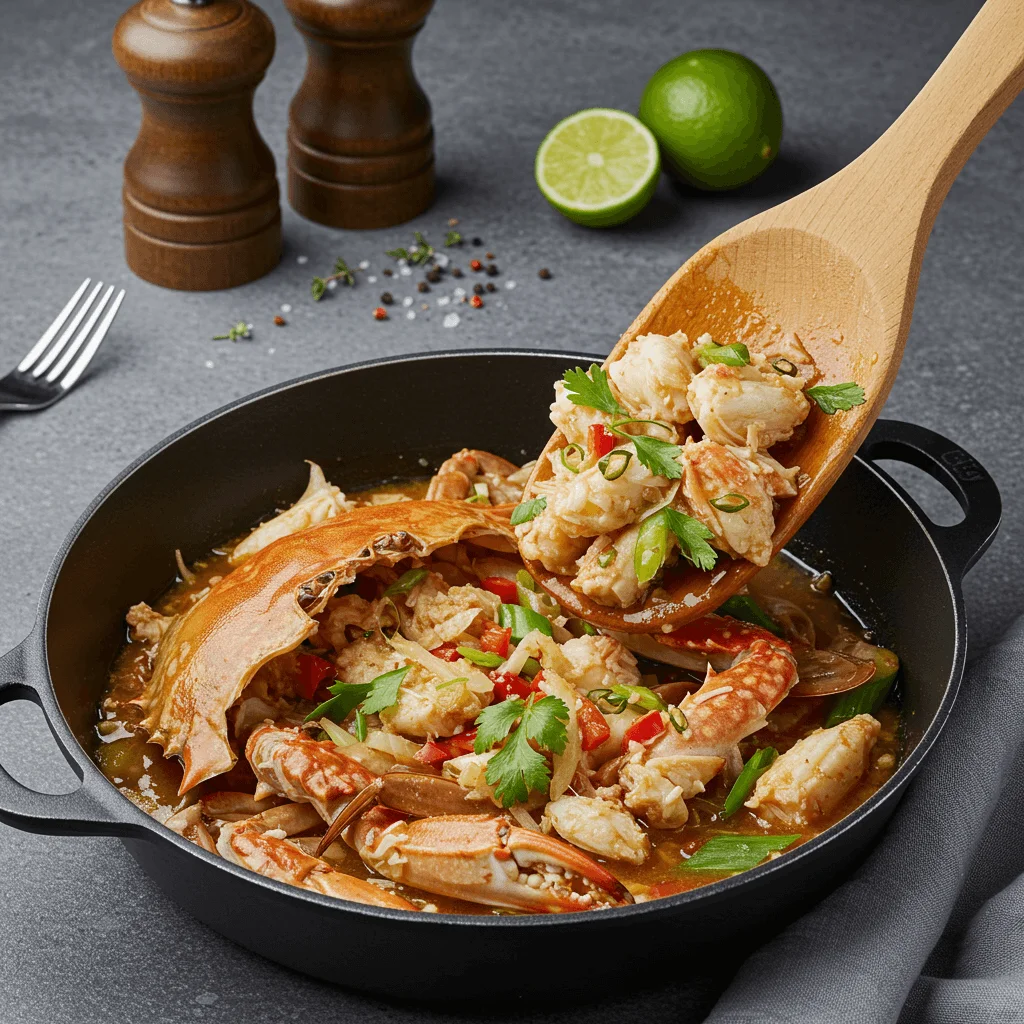Introduction:
Real crab meat is a seafood delicacy known for its sweet, delicate flavor and tender texture. Unlike imitation crab, made from processed fish, real crab meat comes straight from fresh crabs like blue crab, Dungeness crab, or king crab. It’s packed with protein, low in fat, and rich in essential nutrients like omega-3 fatty acids, making it a healthy and flavorful choice for seafood lovers.
Cooking with real crab meat opens up a world of delicious possibilities, from crispy crab cakes to creamy bisques and flavorful pasta dishes. Whether using fresh, canned, or frozen crab meat, knowing how to choose, prepare, and cook it properly ensures the best taste and texture. In this guide, we’ll walk you through everything you need to know about cooking with real crab meat and some easy and delicious recipes to try at home.
Choosing and Preparing Real Crab Meat

Types of Crab Meat and Their Uses
When cooking with real crab meat, understanding the different types available can help you choose the best one for your dish. Crab meat is categorized based on where it comes from on the crab’s body, and each type has unique qualities in texture, flavor, and ideal culinary applications. Here’s a breakdown of the most common types of crab meat and how to use them in your recipes.
1. Jumbo Lump Crab Meat
Description: Jumbo lump crab meat consists of large, whole pieces of muscle from the crab’s two largest swimming legs. It is the most premium and expensive type of crab meat due to its size and delicate texture.
Best Uses:
- Crab cocktails
- Elegant seafood salads
- High-end crab cakes
- Buttered and served as a main course
Because of its size and tenderness, jumbo lump crab meat is best used in dishes where its large pieces remain intact. Avoid recipes that require a lot of stirring or breaking up the meat, as this can ruin its texture.
2. Lump Crab Meat
Description: Lump crab meat mixes broken jumbo lump pieces and smaller white meat chunks from the crab’s body. It has a mild, sweet flavor and a firm yet flaky texture.
Best Uses:
- Crab cakes
- Stuffed seafood (e.g., stuffed shrimp, stuffed mushrooms)
- Crab dips and spreads
- Crab omelets or scrambled eggs
Lump crab meat, with its great texture and affordability, is a smart choice for dishes where you want noticeable chunks of crab without the high cost of jumbo lump.
3. Backfin Crab Meat
Description: Backfin crab meat comprises smaller flakes of white meat from the crab’s body. It has a softer texture than lump crab meat but still offers good flavor.
Best Uses:
- Crab soups and bisques
- Crab stuffing for seafood or poultry
- Pasta dishes (e.g., crab linguine, crab risotto)
- Mixed into dips and spreads
Backfin crab meat, with its smaller, more delicate flakes, is a versatile option that blends well into creamy dishes and soups, allowing you to add flavor without needing large chunks.
4. Claw Meat
Description: Claw meat comes from the crab’s legs and claws. It is darker in color, has a slightly stronger, more pronounced crab flavor, and is firmer in texture compared to white meat varieties.
Best Uses:
- Crab soups and stews
- Stir-fries and fried rice
- Hearty crab cakes with bold seasoning
- Tacos and sandwiches
Claw meat, often more affordable than lump or jumbo lump crab meat, is a budget-friendly option for flavorful dishes. Its firmer texture holds up well in recipes with bold seasonings and sauces, making it a prudent choice for your wallet.
5. Special Crab Meat
Description: Special crab meat consists of small flakes and shreds of white meat from the body cavity of the crab. It has a mild flavor and a soft texture, making it ideal for blending into recipes.
Best Uses:
- Crab dips and spreads
- Casseroles and baked crab dishes
- Blended into crab-based sauces
- Filling for sushi rolls
Special crab meat is often the most affordable type of real crab meat and works well in dishes where the texture doesn’t need to stand out but still provides great flavor.
Which Type of Crab Meat Should You Use?
The best type of crab meat depends on your recipe and budget. If you’re making high-end dishes where presentation matters, jumbo lump or crab meat is the best choice. For soups, dips, and casseroles, backfin, claw, or special crab meat works well and provides excellent flavor without the high price tag.
How to Pick Fresh and High-Quality Crab Meat
Selecting the best real crab meat is essential for achieving your dishes’ perfect flavor and texture. Whether you’re buying fresh, canned, or frozen crab meat, knowing what to look for will ensure you get high-quality seafood. Here’s a complete guide to picking the best crab meat for your recipes.
1. Fresh Crab vs. Pre-Packaged Crab Meat
Before purchasing crab meat, decide whether to buy whole fresh crabs or pre-packaged crab meat. Each option has its pros and cons:
- Fresh Whole Crab – Buying whole crabs ensures the freshest flavor, but you’ll need to clean and extract the meat yourself. This option is best if you enjoy cooking live crabs or breaking down pre-cooked ones.
- Pre-Packaged Fresh Crab Meat – Already extracted and sold in containers, fresh crab meat is convenient and time-saving. Look for high-quality brands that offer minimal preservatives and no artificial additives.
- Canned Crab Meat – A budget-friendly option, canned crab meat is shelf-stable and works well in recipes like dips or casseroles. However, the flavor and texture may not be as fresh as refrigerated or freshly picked crab.
- Frozen Crab Meat – Flash-frozen to preserve quality, frozen crab meat is a good alternative to fresh if you don’t plan to use it right away. Look for vacuum-sealed packaging to ensure minimal freezer burn.
2. Signs of High-Quality Crab Meat
When shopping for crab meat, check the following to ensure you’re getting the best quality:
A. Color and Appearance
- White crab meat should have a fresh, bright appearance with minimal discoloration.
- Claw meat tends to have a slightly darker or reddish hue, which is normal.
- Avoid crab meat with excessive gray, blue, or brownish discoloration, which could indicate spoilage.
B. Smell and Freshness
- Fresh crab meat should have a light, sweet, and oceanic aroma.
- Avoid crab meat with a strong fishy, sour, or ammonia-like smell, which indicates that it is old or spoiled.
C. Texture and Moisture
- High-quality crab meat should be firm, tender, and not mushy or overly watery.
- Avoid crab meat that appears excessively dry or stringy, as it may have been stored improperly.
D. Ingredient List (For Pre-Packaged Crab Meat)
- Check the label to ensure minimal preservatives or added ingredients.
- Opt for products that list only “Crab Meat” and possibly a small amount of salt or natural preservatives.
3. Where to Buy the Best Crab Meat
Finding high-quality crab meat depends on where you shop. Here are some of the best sources:
- Seafood Markets – Local fish markets often sell the freshest crab meat, sourced directly from the coast. Look for markets that specialize in fresh seafood and have high turnover rates.
- Grocery Stores – Many supermarkets carry fresh, canned, or frozen crab meat. Choose well-known brands and check expiration dates.
- Online Seafood Retailers – Some reputable online seafood markets deliver high-quality, fresh, or frozen crab meat directly to your door. Ensure they offer overnight shipping for maximum freshness.
4. Live Crab Buying Tips (If You Prefer to Cook from Scratch)
If you plan to cook whole live crabs, follow these tips for selecting the best ones:
- Activity Level: Pick lively and active crabs, as sluggish ones may be near death.
- Shell Condition: Look for hard-shell crabs with no cracks or missing limbs.
- Weight: Heavier crabs tend to have more meat inside.
- Source: Choose crabs from reputable seafood markets that keep them in clean, well-aerated tanks.
5. Storage Tips for Keeping Crab Meat Fresh
Once you’ve picked high-quality crab meat, store it properly to maintain freshness:
- Fresh Crab Meat: Keep refrigerated at 32–38°F (0–3°C) and consume within 1-2 days.
- Frozen Crab Meat: Store in the freezer for up to 3 months, ensuring it’s well-sealed to prevent freezer burn.
- Cooked Crab Meat: Store in an airtight container in the fridge and use within 3–5 days.
Essential Cooking Tips for Perfect Crab Dishes
Cooking with real crab meat is a great way to enjoy its sweet, delicate flavor but requires proper handling to maintain its texture and taste. Whether you’re making crab cakes, pasta, soups, or salads, following these essential tips will help you prepare the perfect crab dish every time.
1. Handle Crab Meat Gently
Crab meat, especially jumbo lump, and lump varieties is delicate and can break apart easily. To preserve its texture:
- Avoid excessive stirring or mixing, especially when making crab cakes or salads.
- Use a fork or your hands to incorporate crab meat into recipes gently.
- When folding crab meat into batters or fillings, use a light touch to maintain its chunky consistency.
Best Practices:
- For crab cakes, gently fold the ingredients instead of stirring vigorously.
- Add crab meat at the end and toss lightly for pasta or salads.
2. Avoid Overcooking Crab Meat
Crab meat is already cooked when purchased fresh, canned, or frozen. Overcooking can cause it to become dry and rubbery. To keep it tender and flavorful:
- For soups and stews: Add crab meat in the last few minutes of cooking to prevent it from becoming tough.
- For sautés and pasta: Warm it briefly over low heat instead of cooking it for a long time.
- For baked dishes: Cover with foil if necessary to retain moisture and prevent drying out.
Best Practices:
- Heat crab meat just until warmed through, not for extended periods.
- When adding crab to broths or sauces, use a gentle simmer instead of a rolling boil.
3. Enhance Flavor with Complementary Ingredients
Real crab meat has a naturally sweet and mild taste, making it a versatile ingredient. To bring out its best flavor:
- Use fresh citrus like lemon or lime juice to enhance its brightness.
- Add fresh herbs such as parsley, chives, tarragon, or dill for an aromatic boost.
- Pair with mild seasonings like Old Bay, garlic, and shallots without overpowering the crab’s natural taste.
- Incorporate butter or olive oil for richness while maintaining a balanced flavor.
Best Practices:
- Drizzle a bit of lemon juice over crab dishes just before serving.
- Avoid excessive spices or strong sauces that overpower the delicate crab flavor.
4. Properly Drain Canned and Frozen Crab Meat
Removing excess liquid ensures the best texture and prevents dishes from becoming watery if using canned or frozen crab meat.
- Canned crab meat: Drain thoroughly and gently pat dry with a paper towel.
- Frozen crab meat: Let it thaw in the refrigerator overnight, then drain and squeeze out excess moisture before use.
Best Practices:
- Always check for small bits of shell before adding pre-packaged crab meat to recipes.
- If using frozen crab meat, let it reach room temperature before cooking for better consistency.
5. Choose the Right Cooking Methods for Different Dishes
The way you cook crab meat depends on the recipe. Different methods enhance its texture and taste in various ways:
- Sautéing: Best for crab pasta, fried rice, and stir-fried dishes. Use gentle heat and avoid excessive stirring.
- Baking: Great for crab-stuffed dishes, casseroles, and crab dip. Keep it covered to retain moisture.
- Broiling or Grilling: Ideal for crab cakes or whole crabs. A quick broil adds a slight crisp without drying out the meat.
- Boiling or Steaming: Works best for whole crabs but not for pre-packaged crab meat, as it can become waterlogged.
Best Practices:
- For crispier crab cakes, pan-fry or broil instead of baking.
- Mix the crab meat with moist ingredients like cream cheese or mayonnaise when making crab-stuffed recipes.
6. Store Leftover Crab Meat Properly
To maintain the quality of crab meat, store it properly after cooking:
- Refrigeration: Store leftover crab meat in an airtight container and consume within three to five days.
- Freezing: While not ideal for texture, cooked crab dishes can be frozen for up to three months in a sealed container.
- Reheating: Warm crab dishes gently over low heat or in the oven to avoid drying them out.
Best Practices:
- If freezing crab-based soups or dips, allow them to cool before transferring to a freezer-safe container.
- Avoid microwaving crab meat at high heat—use low power to prevent toughness.
Easy and Delicious Real Crab Meat Recipes

Classic Crab Cakes Recipe
Crab cakes are one of the most beloved seafood dishes, known for their crispy golden crust and tender, flavorful interior. Whether served as an appetizer, main course, or sandwich filling, a well-made crab cake highlights the natural sweetness of real crab meat. This classic recipe focuses on simplicity, using fresh ingredients to let the crab shine.
Ingredients
To make the perfect crab cakes, you’ll need:
- 1 pound lump crab meat (picked over for shells)
- ½ cup breadcrumbs (panko or regular)
- 1 large egg (lightly beaten)
- 2 tablespoons mayonnaise
- 1 teaspoon Dijon mustard
- 1 teaspoon Worcestershire sauce
- ½ teaspoon Old Bay seasoning
- ½ teaspoon salt
- ¼ teaspoon black pepper
- 1 tablespoon fresh lemon juice
- 1 tablespoon chopped fresh parsley
- 2 tablespoons unsalted butter (for frying)
- 2 tablespoons olive oil (for frying)
Optional Garnishes:
- Lemon wedges
- Tartar sauce or remoulade
- Fresh herbs (parsley or chives)
Step-by-Step Instructions
1. Prepare the Crab Cake Mixture
- Whisk together the egg, mayonnaise, Dijon mustard, Worcestershire sauce, Old Bay seasoning, salt, pepper, lemon juice, and parsley in a large bowl.
- Gently fold in the crab meat, careful not to break up the lumps.
- Add the breadcrumbs and mix lightly until just combined. The mixture should be moist but firm enough to shape into patties.
Pro Tip: Avoid overmixing to keep the crab cakes light and airy.
2. Shape the Crab Cakes
- Divide the mixture into 6-8 equal portions, depending on the desired size.
- Gently shape each portion into a patty about ¾-inch thick.
- Place the crab cakes on a plate or baking sheet and refrigerate for at least 30 minutes. This helps them hold their shape while cooking.
Pro Tip: Chilling the crab cakes prevents them from falling apart when frying.
3. Cook the Crab Cakes
- Heat the butter and olive oil in a large skillet over medium heat.
- Once hot, carefully place the crab cakes in the pan, ensuring not to overcrowd them.
- Cook for 3-4 minutes per side until golden brown and crispy.
- Transfer the cooked crab cakes to a paper towel-lined plate to remove excess oil.
Pro Tip: If baking instead of frying, preheat the oven to 400°F (200°C) and bake for 15-18 minutes, flipping once halfway through.
Serving Suggestions
Crab cakes are incredibly versatile and can be served in various ways:
- As an appetizer, Serve with lemon wedges and tartar sauce.
- Pair with a fresh green salad or roasted vegetables as a main dish.
- In a sandwich: Place on a toasted bun with lettuce, tomato, and a dollop of remoulade sauce.
Best Side Dishes for Crab Cakes:
- Coleslaw
- Garlic butter asparagus
- Roasted potatoes
- Corn on the cob
Tips for the Best Crab Cakes
- Use fresh lump crab meat: The best crab cakes have large chunks of crab, not shredded pieces.
- Minimize fillers: Too much breadcrumb can make crab cakes dense. Use just enough to hold them together.
- Let them chill before cooking: This prevents them from falling apart in the pan.
- Fry in a butter and oil mix: Butter adds flavor, while olive oil prevents burning.
- Don’t press down while cooking: This keeps the crab cakes tender instead of dense.
Creamy Crab Bisque
Crab bisque is a rich, velvety soup that highlights the delicate sweetness of real crab meat. Inspired by classic French cuisine, this luxurious dish is perfect for special occasions or when craving a comforting yet elegant seafood meal. Made with a smooth, creamy base infused with aromatic herbs and spices, crab bisque delivers a deep, satisfying flavor in every spoonful.
Ingredients
To prepare a delicious and creamy crab bisque, you’ll need. Please note that this recipe contains dairy and seafood, so it may not be suitable for those with allergies to these ingredients:
the Soup Base:
- 2 tablespoons unsalted butter
- 1 tablespoon olive oil
- 1 small onion, finely chopped
- 1 celery stalk, finely chopped
- 1 small carrot, finely chopped
- 2 cloves garlic, minced
- 1 teaspoon Old Bay seasoning
- ½ teaspoon smoked paprika
- ½ teaspoon dried thyme
- 2 tablespoons tomato paste
- ¼ cup dry white wine (optional)
the Creamy Bisque:
- 3 cups seafood stock (or chicken broth for a milder flavor)
- 1 cup heavy cream
- ½ cup whole milk
- 2 tablespoons all-purpose flour (for thickening)
- 1 pound lump crab meat (reserve some for garnish)
- 1 tablespoon Worcestershire sauce
- Salt and black pepper to taste
- 1 tablespoon fresh lemon juice
- 2 tablespoons fresh parsley, chopped
Garnish:
- Extra lump crab meat
- Chopped chives or parsley
- A drizzle of heavy cream
- Croutons or toasted baguette slices
Step-by-Step Instructions
1. Sauté the Aromatics
- Melt the butter with olive oil over medium heat in a large pot.
- Add the chopped onion, celery, and carrot. Sauté for about 5 minutes, stirring occasionally, until the vegetables soften.
- Stir in the minced garlic, Old Bay seasoning, smoked paprika, and dried thyme. Cook for another minute to release the flavors.
2. Build the Flavor Base
- Add the tomato paste and stir to coat the vegetables. Let it cook for about 2 minutes to enhance its depth.
- Pour in the white wine (if using) and let it simmer until mostly evaporated about 2-3 minutes.
- Sprinkle the flour over the mixture and stir well to create a light roux, which will help thicken the bisque.
3. Simmer the Bisque
- Slowly pour in the seafood stock while stirring constantly to avoid lumps.
- Bring the soup to a gentle simmer and cook for 10-15 minutes, allowing the flavors to meld together.
This step is optional and depends on your preference for the bisque’s texture. Pro Tip: For a smoother texture, use an immersion blender to purée the soup at this stage. This will create a velvety, smooth bisque. If you prefer a chunkier bisque, leave it as is.
4. Add the Creamy Elements
- Lower the heat and stir in the heavy cream and whole milk.
- Add the Worcestershire sauce and season with salt and black pepper to taste.
- Let the bisque cook for another 5 minutes, ensuring it doesn’t come to a rolling boil, as this can cause the dairy to separate.
5. Add the Crab Meat
- Gently fold in the lump crab meat and fresh lemon juice.
- Let the soup warm for about 3 minutes, but avoid over-stirring to keep the crab meat intact.
Serving Suggestions
Ladle the hot bisque into bowls and garnish with:
- Extra lump crab meat for a luxurious touch.
- A drizzle of heavy cream for an elegant finish.
- Fresh chopped chives or parsley for color and freshness.
- Croutons or toasted baguette slices for added texture.
Tips for the Best Crab Bisque
- Use fresh or high-quality canned crab meat – Fresh crab meat provides the best flavor, but premium canned or pasteurized crab can work in a pinch.
- Don’t overcook the crab meat – Since it is already cooked, add it towards the end to maintain its tenderness.
- Blend for a silky texture – If you prefer a smooth bisque, purée it before adding the crab meat.
- Balance the flavors – A splash of lemon juice enhances the bisque’s richness without overpowering the delicate crab flavor.
- Use homemade seafood stock if possible – A stock made from crab shells deepens the soup’s natural seafood essence.
Garlic Butter Crab Pasta

Garlic butter crab pasta is a luxurious yet simple dish that combines real crab meat’s rich, buttery flavor with the savory depth of garlic and fresh herbs. This dish is perfect for a special dinner or a weeknight meal when you want to indulge in something flavorful and satisfying without much fuss. The tender crab meat pairs beautifully with pasta in a silky, garlicky butter sauce, creating a comforting meal that’s both elegant and easy to make.
Ingredients
To make a delicious garlic butter crab pasta, you’ll need:
For the Pasta
- 8 oz fettuccine, linguine, or spaghetti (your choice of pasta)
- 1 tablespoon olive oil (for cooking the pasta)
- Salt (for the pasta water)
For the Garlic Butter Sauce
- 4 tablespoons unsalted butter
- 2 tablespoons olive oil
- 4 cloves garlic, minced
- 1 teaspoon red pepper flakes (optional for a slight kick)
- 1 cup dry white wine (or chicken broth as an alternative)
- 1 teaspoon lemon zest
- 1 tablespoon fresh lemon juice
- 1 teaspoon fresh parsley, chopped
- 1 pound lump crab meat (fresh or quality canned)
- Salt and black pepper to taste
Step-by-Step Instructions
1. Cook the Pasta
- Bring a large pot of salted water to a boil.
- Add the pasta and cook according to the package instructions until al dente.
- Reserve 1 cup of pasta water, drain the pasta, and set it aside.
Pro Tip: The reserved pasta water will help to adjust the sauce consistency and bind the pasta to the sauce later.
2. Make the Garlic Butter Sauce
- While the pasta is cooking, heat the butter and olive oil in a large skillet over medium heat.
- Once the butter is melted, add the minced garlic and sauté for 1-2 minutes, until fragrant and golden brown. Be careful not to burn the garlic, making the sauce bitter.
- If you like a little heat, sprinkle the red pepper flakes and sauté for another 30 seconds.
3. Deglaze the Pan
- Pour in the white wine (or chicken broth) to deglaze the pan, scraping up any flavorful bits from the bottom of the skillet.
- Let the wine simmer for 3-4 minutes, allowing it to reduce slightly and intensify in flavor.
- Stir in the lemon zest and fresh lemon juice for brightness and acidity.
4. Add the Crab Meat
- Gently fold the lump crab meat into the sauce, ensuring the meat is well-coated but not broken up too much.
- Cook for 2-3 minutes to warm the crab meat, being careful not to overcook it.
Pro Tip: Overcooking crab meat can cause it to become rubbery, so add it towards the end of cooking to maintain its delicate texture.
5. Toss the Pasta
- Add the cooked pasta to the skillet with the garlic butter sauce and crab.
- Toss everything together, ensuring the pasta is coated evenly in the rich, buttery sauce. If the sauce is too thick, add a splash of the reserved pasta water to loosen it up and help it cling to the pasta.
- Season with salt and black pepper to taste, and stir in fresh chopped parsley for a burst of color and flavor.
Serving Suggestions
Garlic butter crab pasta is a dish that shines on its own, but it can be paired with a variety of sides to elevate the meal:
- A light salad: A fresh green salad with a tangy vinaigrette can balance the richness of the pasta.
- Garlic bread: Toasted garlic bread or crusty baguette slices are perfect for soaking up any extra garlic butter sauce.
- Steamed vegetables: Lightly steamed broccoli or asparagus adds a crisp, fresh element to the meal.
Tips for the Best Garlic Butter Crab Pasta
- Use fresh crab meat: The sweetness of fresh crab is the dish’s star, so opt for a lump or jumbo lump crab meat if possible. If using canned crab, choose a high-quality product for the best flavor.
- Cook the pasta al dente: Pasta slightly firm to the bite will hold up better when tossed in the sauce.
- Don’t overcook the crab meat: Gently heat the crab in the sauce to preserve its tenderness. Overheating can cause it to become tough.
- Adjust the sauce consistency: Use the reserved pasta water to create the perfect consistency. The starchy water helps thicken the sauce and helps it cling to the pasta.
- Add extra flavor with herbs and citrus: A squeeze of fresh lemon juice and a sprinkle of chopped parsley can brighten up the richness of the dish.
Conclusion
Cooking with real crab meat enhances your dishes with its sweet, delicate flavor and offers a high-quality protein source that’s both nutritious and versatile. Whether preparing a classic crab cake, a creamy crab bisque, or a decadent garlic butter crab pasta, the rich taste of real crab meat elevates your recipes.
We hope these recipes have inspired you to experiment in the kitchen and discover how easy and delicious cooking with real crab meat can be. Don’t be afraid to get creative and try your variations! The possibilities are endless when it comes to incorporating crab into your meals.

